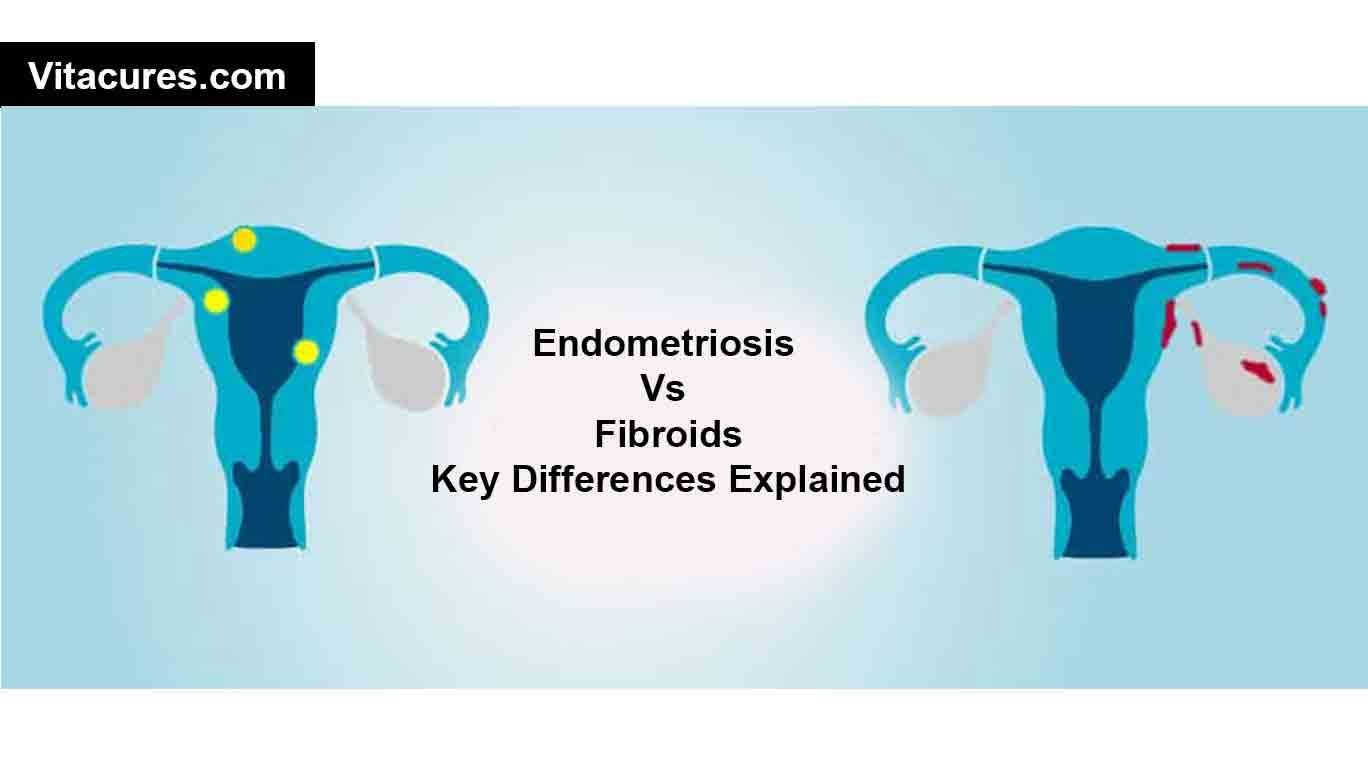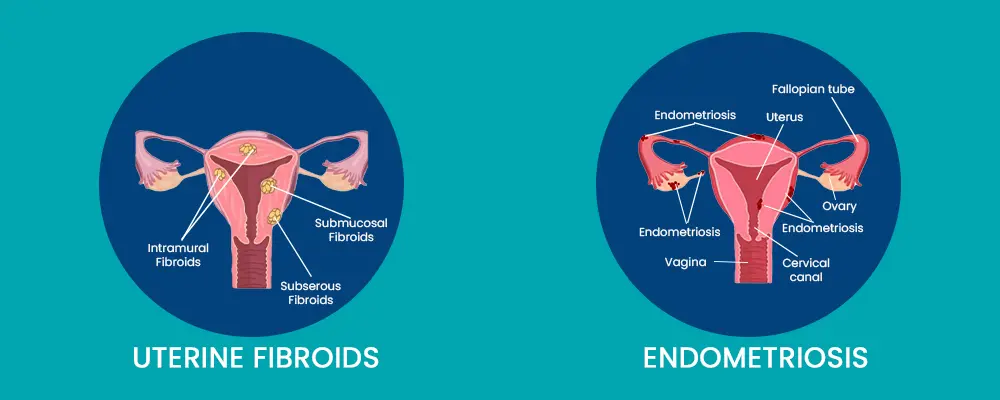Endometriosis Vs Fibroids are two common health issues affecting many women. Both can cause pain and discomfort but differ in their causes and symptoms.
Understanding the differences between endometriosis and fibroids is essential for women facing these conditions. Endometriosis occurs when tissue similar to the lining of the uterus grows outside of it. This can lead to severe pain, especially during menstruation. On the other hand, fibroids are non-cancerous growths in or on the uterus.
They can cause heavy bleeding and pressure in the pelvic area. Knowing how these conditions differ helps in seeking the right treatment. This guide explores the key differences, symptoms, and management options for both endometriosis and fibroids, providing clarity and support for those affected.

you can check: Fertility Calculator / BMI Calculator / BMR Calculator / Health Risks Calculator
Read More: Ashwagandha Can Make You Horny / Vaginal Pump / Omron Blood Pressure / Vitamin C in Daily / vitamin D deficiency / magic wash laundromat / amphound / pixelxoom / cake ideas
Read More: vaginal depth / Vaginal Pump / Vaginal Cuff / Vaginal Dryness / Tighten Your Vagina / Sore Penis After Sex / Nicotine and Your Sex Drive / Why am I so horny? / Sexual Battery
Read more: 8 oz Chicken Breast / Sea Moss Gel / V8 Energy Drinks / 3 eggs calories / Eating Masago
Endometriosis Basics
Understanding endometriosis is crucial for many women. This condition is often confused with fibroids. Both affect women’s health but in different ways. Knowing the basics of endometriosis helps in recognizing its symptoms and seeking proper diagnosis.
What Is Endometriosis?
Endometriosis is a medical condition where tissue similar to the lining inside the uterus grows outside it. This can occur on the ovaries, fallopian tubes, and other organs in the pelvis. The misplaced tissue behaves like normal endometrial tissue. It thickens, breaks down, and bleeds with each menstrual cycle.
Key points about endometriosis:
- Affects about 1 in 10 women of reproductive age.
- Commonly diagnosed in women aged 15 to 49.
- Can lead to infertility and chronic pain.
Endometriosis can be categorized into four stages:
| Stage | Description |
|---|---|
| Stage I | Minimal endometrial implants. |
| Stage II | More implants and deeper tissue involvement. |
| Stage III | Many implants and possible ovarian cysts. |
| Stage IV | Severe endometriosis with extensive scar tissue. |
Symptoms And Diagnosis
Symptoms of endometriosis vary among women. Common symptoms include:
- Painful periods (dysmenorrhea).
- Pain during intercourse.
- Pain with bowel movements or urination.
- Excessive bleeding.
- Infertility issues.
Other symptoms may include fatigue, diarrhea, constipation, bloating, and nausea. These can make daily life challenging.
Diagnosing endometriosis can be complex. Doctors often perform pelvic exams and ultrasounds. A definitive diagnosis usually requires laparoscopic surgery. This allows doctors to see inside the pelvis and take tissue samples for testing.
Early diagnosis is important. It can help manage symptoms effectively and improve quality of life.
Fibroids Explained
Endometriosis and fibroids are two common conditions affecting women’s reproductive health. Understanding fibroids is important for managing symptoms and treatment. Fibroids are non-cancerous growths in the uterus. They can vary in size and number. Knowing the types and signs can help women seek the right care.
Types Of Fibroids
Fibroids come in different types, each with unique characteristics. They can grow in various locations in the uterus. Here are the main types:
- Intramural Fibroids: These grow within the uterine wall. They are the most common type.
- Subserosal Fibroids: These develop on the outer wall of the uterus. They can grow large and cause pressure on nearby organs.
- Submucosal Fibroids: These grow just beneath the inner lining of the uterus. They can affect menstrual bleeding and fertility.
- Cervical Fibroids: These occur in the cervix. They can sometimes cause discomfort during intercourse.
Here’s a table summarizing these types:
| Type of Fibroid | Location | Common Effects |
|---|---|---|
| Intramural | Within uterine wall | Menstrual pain, pressure |
| Subserosal | Outer uterine wall | Pelvic pressure, back pain |
| Submucosal | Under inner lining | Heavy bleeding, fertility issues |
| Cervical | Cervix | Discomfort during intercourse |
Understanding these types helps in identifying potential issues and planning treatment. Each type can affect health differently.
Signs And Symptoms
Fibroids can cause various signs and symptoms. Many women experience no symptoms at all. However, some may face significant discomfort. Here are common signs of fibroids:
- Heavy Menstrual Bleeding: Women may notice unusually heavy periods.
- Pelvic Pain: Constant pain or pressure in the pelvic region is common.
- Frequent Urination: Fibroids can press against the bladder, causing frequent bathroom trips.
- Constipation: Pressure on the intestines may lead to constipation.
- Back Pain: Some women may experience lower back pain.
These symptoms can vary in intensity. It is important to consult a healthcare provider if symptoms worsen.
Here is a brief overview of symptoms:
| Symptom | Description |
|---|---|
| Heavy Menstrual Bleeding | Periods that require changing pads or tampons every hour. |
| Pelvic Pain | Chronic pain that can affect daily activities. |
| Frequent Urination | Need to urinate more often than usual. |
| Constipation | Difficulty in bowel movements due to pressure. |
| Back Pain | Pain in the lower back that can radiate. |
Recognizing these signs early can lead to better management and treatment of fibroids.
Causes And Risk Factors
Understanding the differences between endometriosis and fibroids is crucial for women’s health. Both conditions affect the uterus but have different causes and risk factors. Knowing these can help in early detection and management. This section explores the triggers for endometriosis and the factors that contribute to fibroid development.
Endometriosis Triggers
Endometriosis occurs when tissue similar to the lining of the uterus grows outside it. Several factors can trigger or worsen this condition. These triggers vary among women but include:
- Hormones: Estrogen plays a significant role in endometriosis. Higher levels can worsen symptoms.
- Genetics: A family history of endometriosis increases the risk of developing the condition.
- Menstrual flow: Retrograde menstruation, where menstrual blood flows back into the pelvis, may contribute to endometriosis.
- Immune system issues: A weak immune system may fail to recognize endometrial tissue growing outside the uterus.
Here is a table summarizing common endometriosis triggers:
| Trigger | Description |
|---|---|
| Hormonal Changes | Estrogen levels can stimulate endometrial tissue growth. |
| Genetics | Family history increases the likelihood of endometriosis. |
| Menstrual Flow Issues | Backflow of menstrual blood may lead to endometriosis. |
| Immune System Defects | A weak immune system may not eliminate abnormal tissue. |
Identifying these triggers can help in managing endometriosis and improving quality of life.
Fibroid Development Factors
Uterine fibroids are non-cancerous growths in the uterus. Several factors can influence their development:
- Hormonal Influence: Estrogen and progesterone promote fibroid growth.
- Age: Women aged 30-40 are more likely to develop fibroids.
- Genetics: A family history of fibroids increases the risk.
- Obesity: Higher body weight can elevate estrogen levels.
Here is a table summarizing factors that contribute to fibroid development:
| Factor | Description |
|---|---|
| Hormonal Factors | Estrogen and progesterone stimulate fibroid growth. |
| Age | Risk increases for women in their 30s and 40s. |
| Genetic Factors | Family history may lead to a higher risk of fibroids. |
| Body Weight | Obesity is linked to higher estrogen levels, raising fibroid risk. |
Recognizing these factors helps women understand their health and seek appropriate care.

Credit: www.fibroidcare.co.za
Diagnosis Methods
Understanding the diagnosis methods for endometriosis and fibroids is crucial. Both conditions can cause similar symptoms but require different approaches for accurate diagnosis. Knowing how doctors identify these issues helps women seek the right treatment. This section covers how each condition is tested and identified.
Endometriosis Testing
Diagnosing endometriosis can be challenging. Doctors often use various methods to confirm the presence of this condition. Common tests include:
- Pelvic Exam: A doctor checks for abnormalities.
- Ultrasound: This imaging test helps visualize cysts.
- Magnetic Resonance Imaging (MRI): Provides detailed images of reproductive organs.
- Laparoscopy: A surgical procedure that allows direct viewing of the pelvic organs.
A laparoscopy is the most definitive test. During this procedure, a small camera is inserted into the abdomen. Doctors can see endometrial tissue outside the uterus. They may also take a biopsy for further analysis.
Here is a table summarizing the endometriosis testing methods:
| Test | Purpose |
|---|---|
| Pelvic Exam | Check for abnormalities |
| Ultrasound | Visualize cysts and other issues |
| MRI | Detailed imaging of reproductive organs |
| Laparoscopy | Direct viewing and biopsy of tissue |
Early diagnosis is important. It leads to better treatment options and improved quality of life for those affected.
Fibroid Identification Techniques
Identifying fibroids involves different methods. These non-cancerous growths can be detected through several tests:
- Pelvic Exam: Similar to endometriosis, doctors can feel fibroids during an exam.
- Ultrasound: This is the primary tool for detecting fibroids.
- Sonohysterography: A special ultrasound that uses saline to get clearer images.
- MRI: Offers detailed images to assess the size and location of fibroids.
Doctors may recommend a hysteroscopy too. This procedure involves inserting a camera into the uterus. It helps view fibroids inside the uterine cavity.
The following table summarizes the fibroid identification techniques:
| Technique | Purpose |
|---|---|
| Pelvic Exam | Feel for growths |
| Ultrasound | Detect fibroids |
| Sonohysterography | Clearer imaging of the uterus |
| MRI | Detailed assessment of fibroid size and location |
| Hysteroscopy | Direct view of uterine cavity |
Understanding these techniques helps women be proactive about their health. Early detection leads to better management of symptoms.
Treatment Options
Understanding the treatment options for endometriosis and fibroids is essential. Both conditions affect many women and can cause pain and discomfort. Effective management can improve quality of life. Treatment varies based on symptoms and individual needs. Options range from medication to surgery. Knowing the choices helps in making informed decisions.
Endometriosis Management
Managing endometriosis often requires a multi-faceted approach. Treatment aims to relieve pain and improve fertility. Options include:
- Medications: Pain relievers like NSAIDs can help reduce pain.
- Hormonal Therapy: Hormonal treatments can help control symptoms by reducing menstruation.
- Physical Therapy: Physical therapy can relieve pelvic pain and improve function.
- Surgery: In severe cases, surgery may be needed to remove endometrial tissue.
Hormonal therapy is often a first step for many women. It can include:
- Birth control pills
- Gonadotropin-releasing hormone (GnRH) agonists
- Progestin therapy
For those with severe symptoms or fertility issues, surgery may be recommended. This could involve:
| Treatment Type | Description |
|---|---|
| Laparoscopy | Minimally invasive surgery to remove endometriosis implants. |
| Hysterectomy | Removal of the uterus, often with ovaries, for severe cases. |
Each option has benefits and risks. Discussing these with a healthcare provider is crucial.
Fibroid Treatment Approaches
Treating fibroids depends on their size, number, and symptoms. Many women do not need treatment if fibroids are small and symptom-free. Common treatment options include:
- Medications: Hormonal treatments can help manage symptoms.
- Non-invasive Procedures: MRI-guided focused ultrasound can reduce fibroid size.
- Surgical Options: Surgery may be necessary for larger or symptomatic fibroids.
Medications may include:
- Birth control pills
- GnRH agonists
- Anti-inflammatory drugs
Surgical options include:
| Treatment Type | Description |
|---|---|
| Myomectomy | Removal of fibroids while preserving the uterus. |
| Hysterectomy | Complete removal of the uterus for severe cases. |
Choosing the right treatment involves considering personal health and preferences. A healthcare provider can guide the decision-making process.
Impact On Fertility
Endometriosis and fibroids are two common conditions affecting women’s reproductive health. Both can impact fertility in different ways. Understanding these effects is essential for women trying to conceive. Endometriosis can lead to inflammation and scar tissue, while fibroids can block the uterus or fallopian tubes. This section explores the effects of both conditions on fertility.
Endometriosis And Conception
Endometriosis can significantly affect a woman’s ability to conceive. This condition occurs when tissue similar to the lining of the uterus grows outside the uterus. It can cause pain and lead to scar tissue. Here are some key points about endometriosis and conception:
- Endometriosis can lead to infertility in about 30-50% of women.
- It causes inflammation, which can harm the eggs and sperm.
- Blocked fallopian tubes may prevent sperm from reaching the egg.
- Scar tissue can distort pelvic anatomy.
Many women with endometriosis may still conceive naturally. Treatments are available to improve chances:
- Medications for pain relief.
- Hormonal therapy to reduce endometrial tissue.
- In vitro fertilization (IVF) for severe cases.
It is crucial for women with endometriosis to consult with a healthcare provider. Early diagnosis and treatment can improve fertility outcomes.
Fibroids And Pregnancy
Fibroids are non-cancerous growths in the uterus. They can also affect fertility and pregnancy. The impact of fibroids on fertility varies depending on their size and location. Here are important facts regarding fibroids and pregnancy:
| Type of Fibroid | Impact on Fertility |
|---|---|
| Submucosal Fibroids | Can reduce fertility by affecting the uterine cavity. |
| Intramural Fibroids | May cause complications during pregnancy. |
| Subserosal Fibroids | Usually do not affect fertility. |
Women with fibroids may experience:
- Heavy menstrual bleeding.
- Pelvic pain.
- Complications during pregnancy, such as preterm labor.
In many cases, women with fibroids can still become pregnant. Treatments like myomectomy can help remove problematic fibroids. Regular check-ups with a doctor are important for managing symptoms and monitoring fertility.
Lifestyle Modifications
Endometriosis and fibroids are common conditions affecting women’s health. Both can cause discomfort and impact daily life. Making lifestyle changes can help manage symptoms. Diet and exercise play key roles in improving health. Let’s explore how these modifications can help.
Diet And Endometriosis
Diet can significantly affect endometriosis symptoms. Certain foods can help reduce inflammation and pain. A balanced diet is essential for overall health. Here are some dietary tips:
- Increase fruits and vegetables: They contain antioxidants that fight inflammation.
- Incorporate whole grains: Foods like brown rice and quinoa can help stabilize hormones.
- Choose healthy fats: Omega-3 fatty acids found in fish and flaxseeds can reduce inflammation.
- Avoid processed foods: These can increase inflammation and worsen symptoms.
- Limit red meat: Studies suggest a link between red meat and increased pain.
Here’s a simple table to summarize beneficial and harmful foods:
| Beneficial Foods | Foods to Avoid |
|---|---|
| Leafy greens | Sugar-sweetened drinks |
| Berries | Refined carbs |
| Fatty fish | Processed snacks |
| Nuts and seeds | High-fat dairy |
Staying hydrated is also crucial. Drink plenty of water throughout the day. This helps your body function better and may ease symptoms.
Exercise For Fibroids
Regular exercise is vital for managing fibroids. It helps improve blood flow and reduce stress. Stress can worsen symptoms. Here are some effective exercises:
- Walking: A simple yet effective way to stay active.
- Yoga: Helps relax the body and reduce tension.
- Strength training: Builds muscle and supports overall health.
- Aerobic exercises: Activities like swimming or cycling enhance cardiovascular health.
Consider these tips to make exercise a part of your routine:
- Set realistic goals.
- Choose activities you enjoy.
- Start slowly and gradually increase intensity.
- Stay consistent for best results.
Remember, exercise not only helps with symptoms but also improves your mood. Staying active can bring positive changes to your life.
Comparative Insights
Endometriosis and fibroids are common conditions that affect women’s health. Both can cause pain and discomfort but differ in their nature and treatment. Understanding these conditions helps in managing symptoms and seeking the right care. This section dives into comparative insights about endometriosis and fibroids, highlighting their similarities and key differences.
Similarities Between Conditions
Endometriosis and fibroids share several common features. Both conditions can lead to significant pain and affect a woman’s quality of life. Here are some similarities:
- Pelvic Pain: Both conditions often cause chronic pelvic pain.
- Heavy Menstrual Bleeding: Women may experience heavy periods or bleeding between cycles.
- Infertility Issues: Both can contribute to difficulty in getting pregnant.
- Hormonal Influence: Each condition responds to hormonal changes in the body.
- Diagnosis Challenges: Both conditions can be hard to diagnose and may require imaging or surgery.
These similarities can lead to confusion. Women may not know which condition they have. A proper diagnosis is essential for effective treatment.
| Feature | Endometriosis | Fibroids |
|---|---|---|
| Pelvic Pain | Common | Common |
| Heavy Menstrual Bleeding | Possible | Common |
| Infertility | Possible | Possible |
| Hormonal Influence | Yes | Yes |
Key Differences
Endometriosis and fibroids have important differences. Understanding these can help in choosing the right treatment.
- Nature of Condition: Endometriosis involves tissue similar to the uterine lining growing outside the uterus. Fibroids are non-cancerous growths in or on the uterus.
- Location: Endometriosis can affect various organs. Fibroids are typically found within the uterus.
- Symptoms: Endometriosis often causes severe pain during periods. Fibroids may cause pressure symptoms, like frequent urination.
- Treatment: Endometriosis may require hormonal therapy or surgery to remove tissue. Fibroids can be treated with medication or surgery to remove fibroids.
These differences highlight the need for accurate diagnosis. Each condition requires a tailored approach for effective management.
| Aspect | Endometriosis | Fibroids |
|---|---|---|
| Type | Tissue growth outside the uterus | Non-cancerous tumors in the uterus |
| Symptoms | Severe pain, heavy bleeding | Pressure, heavy bleeding |
| Treatment | Hormonal therapy, surgery | Medication, surgery |

Credit: www.reviveresearch.org
Frequently Asked Questions
How To Tell The Difference Between Endometriosis And Fibroids?
Endometriosis involves tissue growing outside the uterus, causing pain and heavy periods. Fibroids are noncancerous tumors in the uterus, often causing pressure and bleeding. Symptoms, location, and imaging tests can help differentiate between the two conditions. Consult a healthcare professional for an accurate diagnosis.
What Does A Fibroid Belly Look Like?
A fibroid belly may appear swollen or distended. It can feel firm or lumpy due to the growth of fibroids. Some women notice changes in their body shape, particularly in the lower abdomen. Symptoms may include discomfort, bloating, or pressure.
Regular check-ups can help monitor any changes.
What Are Three Signs Of Endometriosis?
Three signs of endometriosis include painful periods, chronic pelvic pain, and pain during intercourse. Other symptoms may involve heavy menstrual bleeding and infertility. Recognizing these signs early can lead to effective management and treatment options. Always consult a healthcare professional for accurate diagnosis and personalized advice.
What Do Inflamed Fibroids Feel Like?
Inflamed fibroids can cause pelvic pain or pressure. They may lead to heavy menstrual bleeding and discomfort during intercourse. Some women experience bloating and frequent urination. Symptoms vary by individual but often significantly impact daily life and well-being. Consulting a healthcare professional is essential for proper diagnosis and treatment.
Conclusion
Understanding endometriosis and fibroids is important for women’s health. Both conditions affect many women but differ in symptoms and treatment. Endometriosis often causes pain and affects fertility. Fibroids can cause heavy bleeding and pressure. Knowing the differences helps in seeking the right care.
Talk to a healthcare provider for proper diagnosis and treatment options. Take charge of your health. Awareness is the first step toward better management. Always prioritize your well-being and stay informed about your body.



